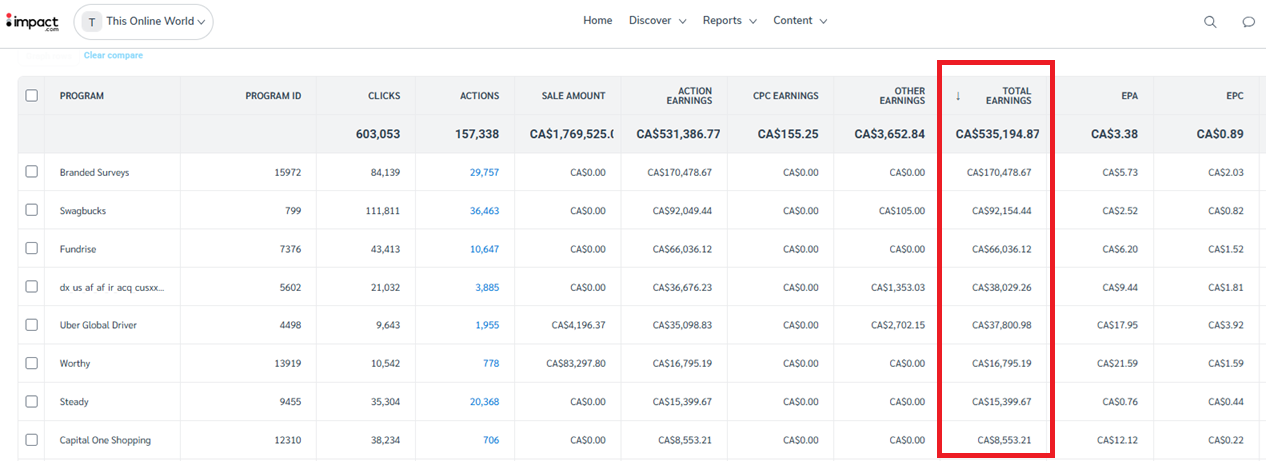These 3 Offers Made Me $1+ Million In My Twenties
If You're A Content Creator - You Can Do The Same Thing
In 2017, I started trying to make money online for the first time.
Most of the ideas I tried were epic failures.
I wrote content on Hubpages. I started a failed Amazon affiliate website about headphones. I ran a phone farm….
None of these ideas ever made me more than $25 per month, if that. In fact, I lost money when you consider all the time, energy, and startup costs I put into them. And my Etsy print on demand business even got shut down for stealing some Spongebob memes.
Undeterred, I started another project in 2018 - This Online World.
This blog would only make $1,700 in its first 12 months. But fast forward a couple of years, and I had crossed the $1 million revenue mark, exited my business, and gained locational and financial freedom.
But here’s the thing: most of this revenue came from three simple offer types, which I’m going to share with you now.
And none of these offers required super technical marketing, a bankroll for running ads, or secret industry connections.
All they required was consistent effort and a bit of honesty. Which is why you can do the exact same thing if you’re a creator.
Let’s dive in.
1. Offer Type One: Free & Low-Ticket Affiliate CPA Offers
I think a lot of people chase high-ticket affiliate programs when they first start out.
This is partly why I first started an affiliate site about speakers and high-end audio systems. I thought hey: getting paid 5% on a $2,000 sound system sounds pretty slick!
But this isn’t actually what worked for me. And if you don’t know the ins and outs of an industry, you really have no business being an affiliate in it (I know nothing about sound systems.)
But you know what I did know a lot about back in 2018?
Paid survey websites, reward apps, and the world of beermoney (thanks, phone farming!)
So, I started creating content about these various sites and apps. I’d spend a couple days testing one out, write a review about it, and slap it on my blog.
Most of these apps have affiliate or referral programs.
They don’t pay much - usually $1 to $5 CPA at most. But there’s almost no friction for people to sign up and for you to get paid. Someone legitimately just needs to enter their email to sign up for free, and you get a commission.
Over the course of a few years, I worked closely with companies like Swagbucks, Survey Junkie, Branded Surveys, and plenty of others. I also got into the gig economy space with partners like DoorDash and Uber Eats. You can see my old Impact account above, which is one of my favorite networks still I recommend checking out.
This entire affiliate play also taught me a couple of valuable lessons.
The first was the value of honesty.
At the time (and still to this day) - most affiliates for these apps or services don’t actually download and test out the products they’re promoting.
It’s as clear as day. Plus, most affiliates give everything a 5/5 star rating and promise people they’ll get rich overnight.
People aren’t stupid. They can sense when an affiliate marketer is lying to them. And this is why being honest and actually doing the bit of extra work to test out what you’re promoting puts you miles ahead of most of your competition.
I think this is a large reason my blog content and YouTube videos have done so well and gotten traffic. Even to this day, my reviews generate affiliate sales every day. Plus, there’s an endless number of new apps and companies entering this space to also partner with.
But the second main takeaway is that content creators shouldn’t be scared of lower-ticket offers. This is because they often have lower competition and almost no friction for the customer.
In my case, the massive personal finance publications weren’t really touching these offers when I got started. There are the FinanceBuzz’s and Penny Hoarder’s out there, but I’ve never had as much competition in this niche as other finance niches, like banking or credit cards.
Look around your own niche for these opportunities. I’m sure they’re out there.
2. Offer Type Two: Display Advertising Income
This offer type is much simpler. It’s essentially getting paid to get eyeballs on your content.
For me, I did this in two main ways at the start: Google AdSense, and then Mediavine ads on my website This Online World.
A lot of people discount display advertising. However, I think it’s an amazing way to monetize early on as a content creator. There’s just something about seeing consistent income coming in every day, even if it’s pennies. It just proves to you that what you’re doing is legit and actually works.
Adsense never did much for me. Mediavine on the other hand, turned into a cash cow. At its peak, it was earning around $20,000 per month.
I’ll admit, generating this much organic traffic to a blog is much harder these days. But I still think bloggers should dabble in display ads. Companies like Mediavine also have new programs (Journey) now that are easier to qualify for.
You don’t have to stick to blogging though. In 2025 and beyond, I think more creators should think about long-form YouTube content.
Not only is long-form video a great play for affiliate CPA offers, but the AdSense on your videos can be pretty solid in many niches. It’s also way higher than what you’ll get on Reels, Shorts, or TikToks.
This is a newer income stream I’m ramping up on a few YouTube channels. It’s worked for my main channel Tom Blake, so I’m expanding the strategy to a few more niches this year and moving forwards. I’ll update people here on Substack how these new channels are cooking up!
If you’re currently creating blog content, definitely look into display ads. And if you’re mostly making short-form content, I suggest giving long-form a try (especially if you’re an affiliate marketer)
💵 Get my YouTube Freedom Blueprint here to learn how to scale your own profitable channel and to access my new Skool Community for ongoing support and YouTube secrets.
3. Offer Type Three: Freelance Services
The third offer type that I’ve used throughout my twenties has been freelancing.
I know some content creators or online gurus out there are against “trading time for money.” But trading time for money can be awesome, especially when you’re scaling your income.
For me, this looked like freelance writing most of the time.
Especially back in 2018 and for the next year or two. I had quit my office job and bought a one-way ticket down to Colombia. I was still growing my blog and learning the ropes, so I needed somewhat stable income to get by.
Freelance content creation in the same niche you’re an affiliate for is honestly awesome.
Yes, you’re competing against your own content and brand in some sense when you do this. But you’re also getting paid by clients to create content you know like the back of your hand.
In many cases, I’d create content on my YouTube channel or blog and monetize it myself. A month later, a client would ask me to make similar content for them. It was a walk in the park and really solid hourly pay. There have also been instances where I’ve landed brand sponsorships for myself and my freelancing client, which made everyone quite happy.
If you’re a content creator, I suggest offering some sort of professional service to brands besides sponsored content.
You’d be amazed at the deals you can land.
I know content creators who earn $10,000 a month being the face of certain brands. I know others who make a killing as social media managers, or YouTube strategists.
And sure, this is trading time for money. But you can always outsource the work you don’t like. Plus, adding these sorts of professional services into your mix helps expand your network and provide some income diversity in case other offers of yours tank.
What Can You Do To Scale Your Income?
So, what’s next?
Well if you’re also a content creator, I have a couple quick suggestions.
Look for lower-ticket, less competitive CPA affiliate offers and make content about these. Right now, I use Impact, MaxBounty, and Panthera the most out of the many affiliate networks out there.
Start making long-form videos if you’re only making short-form content. You can then use tools like Opus Clips to repurpose your long-form videos into short-form anyways.
Add a professional service to your lineup and pitch this to the brands you’ve worked with. You can also add this to something like a Pillar page alongside your media kit. Here’s mine as an example.
In my experience, these three offer types can have a way higher upside (and quickly) then trying to sell memberships or your own course/digital products.
There’s nothing wrong with these offer types either. But as someone who chased a lot of higher-ticket stuff out of the gate, I’ve learned that the simple stuff sometimes works great.
Anyways, this is just what’s worked for me over the last few years. This year, I want to mix in digital products, newsletters, and more YouTube channels into the mix alongside these 3 core offer types.
I’ve been writing blog and YouTube income reports for years. I don’t think I’ll bring these back, but I’ll certainly be sharing more of what works (and what doesn’t) here on Substack from here on out. Hopefully, you find value in it if you’re a fellow content creator.
Thanks for reading!
Catch you in the next one.








